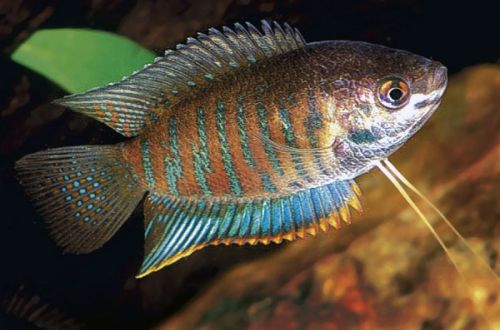
striped gourami
Striped Colisa, Striped Gourami or Banded Gourami, scientific name Trichogaster fasciata, belongs to the Osphronemidae family. The fish has many advantages from the point of view of a novice aquarist, it is easy to keep, unpretentious, easy to breed and compatible with other species. In addition, it has a bright color. All together makes Coliseum an excellent choice for the home aquarium.

Contents
Habitat
It comes from the vast territory of the Hindustan Peninsula in Southeast Asia. Inhabits sluggish water bodies and dense floating vegetation, also found in irrigation canals and rice fields.
Brief information:
- The volume of the aquarium – from 70 liters.
- Temperature – 21-28°C
- Value pH — 6.0–7.5
- Water hardness – soft to medium hard (1-15 dGH)
- Substrate type – any dark
- Lighting – subdued
- Brackish water – no
- Water movement – little or no
- The size of the fish is up to 10 cm.
- Food – any food
- Temperament – peaceful
- Content both singly and in a group
Description
Adult males reach a length of about 10 cm, the color is bright, combines orange and blue colors. The body pattern consists of diagonal stripes and specks on the tail and fins, the latter having pointed tips. Females are less bright and inferior to males in size.
Food
Being completely unpretentious to the diet, Striped Colisa will accept most popular dry, frozen and live foods. A varied diet, including various types of foods, favorably affects the brightness of the color of the fish.
Maintenance and care, arrangement of the aquarium
The optimal volume of the tank for one pair of fish starts from 70 liters. The decoration uses dense clusters of floating shade-loving plants, a dark substrate and shelters in the form of snags, ceramic pots turned on their side or decorative objects such as sunken ships, castles, etc.
The conditions of detention are characterized by a low level of illumination and soft filtration, which does not create excessive internal flow. The hydrochemical parameters of the water must be within neutral pH values at low or medium hardness (dGH). To avoid accidental jumping out, the aquarium should be equipped with a lid, which also helps to maintain a warm, moist layer of air above the surface, which is important for the respiration of labyrinth fish.
Maintenance comes down to regular cleaning of the soil from organic waste and weekly water changes (10–15% of the volume) with fresh water.
Behavior and Compatibility
Relatively peaceful species, with the exception of spawning periods, when males become quite aggressive towards each other. They can be kept both singly and in mixed groups (male / female). Flocks of peaceful fish from among the haracin and cyprinids are suitable as neighbors. Sharing with a close relative of Labioz should be avoided to prevent the appearance of hybrid offspring.
Breeding / breeding
Spawning is recommended to be carried out in a separate tank. For these purposes, a small aquarium from 30–40 liters is suitable, filled with water only halfway – an imitation of shallow water, with numerous floating plants. Water conditions should correspond to the general aquarium. The set of equipment consists of a simple airlift filter, a heater and a low power lamp. A lid is a must.
The mating season in the artificial environment begins regardless of the season, so when some fish become noticeably rounder, while others acquire a more saturated color, then it’s time to prepare a spawning aquarium. The female is transplanted first, the male joins after a couple of days and, as a rule, immediately begins to build a nest of bubbles among dense thickets of plants, which can reach 5 cm or more in diameter.
Spawning itself is accompanied by a kind of “embrace”, during which eggs and seeds are released. The fertilized eggs are picked up by the male and transferred to the nest. Further, the female does not take part in caring for the offspring and can be moved back, while the male remains to guard the clutch and fry in the first days of their life, until they begin to swim freely in search of food. This takes about 4-5 days, then it is also returned to the general aquarium.
Fish diseases
The main cause of most diseases is unsuitable living conditions and poor-quality food. If the first symptoms are detected, you should check the water parameters and the presence of high concentrations of hazardous substances (ammonia, nitrites, nitrates, etc.), if necessary, bring the indicators back to normal and only then proceed with treatment. Read more about symptoms and treatments in the Aquarium Fish Diseases section.





